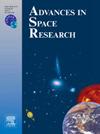利用 WRF 模型模拟孟加拉国上空雷暴时积云参数化方案和数据源的敏感性分析
IF 2.8
3区 地球科学
Q2 ASTRONOMY & ASTROPHYSICS
引用次数: 0
摘要
为了优化天气研究和预报(WRF)模型,对测试雷暴事件进行了敏感性分析,以确定用于模拟孟加拉国上空雷暴的积云物理(CU)和数据源选项的最佳组合。为此采用了三种积云物理学方案的六种组合,即 Kain-Fritsch 方案 (KF) (CU-1)、Betts-Miller-Janjic 方案 (BMJ) (CU-2) 和 Grell-Dévényi (GD) 集合方案 (CU-3),以及两种不同的数据源,即国家环境预报中心 (NCEP) 的最终分析 (FNL) 和全球预报系统 (GFS) 数据。WRF 模型在水平分辨率为 9 千米的单一域上运行,利用这些积云物理学和六小时 GFS/FNL 数据集的组合,分别作为测试事件-1 和测试事件-2 的初始和横向边界条件,时间跨度为 48 小时;从 2017 年 5 月 14 日 0 时至 2017 年 5 月 16 日 0 时,以及从 2018 年 3 月 29 日 0 时至 2018 年 3 月 31 日 0 时。模型模拟输出的降雨量、相对湿度、平均海平面气压和温度与孟加拉国气象局(BMD)的观测数据进行了比较。然后计算每个模拟参数的绝对误差。根据每个参数的均方根误差(RMSE),选择了更好的积云物理学和数据源组合。结果发现,CU-1 和 GFS 数据集组合在事件-1 的 12 个部分中的 4 个部分以及事件-2 的 12 个部分中的 5 个部分显示出较小的均方根误差。因此,Cu_1 和 GFS 数据集组合可用于模拟孟加拉国上空的雷暴天气。在确定了模式物理选项和数据集之后,模拟了另一个 TS 测试案例,并分析了不同参数,以证明 WRF 设置的合理性。结果发现,WRF 模型很好地捕捉了 MSLP、温度和相对湿度。但在降雨量方面,模拟值远远小于观测值。为了提高准确性,可以进行更多的案例研究,包括天气晴好的日子和天气恶劣的 TS 日。本文章由计算机程序翻译,如有差异,请以英文原文为准。
Sensitivity analysis of cumulus parameterization scheme and data sources to simulate thunderstorms over Bangladesh using WRF model
To optimize weather research and forecasting (WRF) model, a sensitivity analysis has been performed for test thunderstorm events to determine the best combination of cumulus physics (CU) and data source options to be used for simulating thunderstorms over Bangladesh. Six combinations for three cumulus physics options namely, Kain-Fritsch Scheme (KF) (CU-1), Betts-Miller-Janjic Scheme (BMJ) (CU-2) and Grell-Dévényi (GD) Ensemble Scheme (CU-3) and two different data sources namely, National Center for Environmental Prediction (NCEP) Final Analysis (FNL) and the Global Forecast System (GFS) data have been used for this purpose. WRF model has been run on a single domain of 9 km horizontal resolution utilizing the combinations of these cumulus physics and six hourly GFS/FNL datasets for 48 h; from 0000 UTC of 14 May 2017 to 0000 UTC of 16 May 2017 and from 0000 UTC of 29 March 2018 to 0000 UTC of 31 March 2018 as initial and lateral boundary conditions for test event-1 and test event-2 respectively. Model simulated output for rainfall, relative humidity; mean sea level pressure and temperature have been compared with the observed data of Bangladesh Meteorological Department (BMD). Then absolute error of each simulated parameter has been calculated. On the basis of root mean square error (RMSE) for each parameter, better cumulus physics and data source combination has been selected. It is found that, CU-1 and GFS dataset combination exhibits less RMS error in 4 sections out of 12 sections for event-1 and in 5 sections out of 12 sections for event-2. So, it may be expected that Cu_1 and GFS dataset combination may be used for simulating thunderstorm over Bangladesh. After finalizing model physics options and data sets, another test case of TS has been simulated and different parameters are analyzed for justification of WRF setup. It is found that WRF model captured MSLP, temperature and relative humidity very well. But in case of rainfall the simulated value is much smaller than the observed value. For more accuracy more case studies may be carried out including for fair weather days as well as severe TS days.
求助全文
通过发布文献求助,成功后即可免费获取论文全文。
去求助
来源期刊

Advances in Space Research
地学天文-地球科学综合
CiteScore
5.20
自引率
11.50%
发文量
800
审稿时长
5.8 months
期刊介绍:
The COSPAR publication Advances in Space Research (ASR) is an open journal covering all areas of space research including: space studies of the Earth''s surface, meteorology, climate, the Earth-Moon system, planets and small bodies of the solar system, upper atmospheres, ionospheres and magnetospheres of the Earth and planets including reference atmospheres, space plasmas in the solar system, astrophysics from space, materials sciences in space, fundamental physics in space, space debris, space weather, Earth observations of space phenomena, etc.
NB: Please note that manuscripts related to life sciences as related to space are no more accepted for submission to Advances in Space Research. Such manuscripts should now be submitted to the new COSPAR Journal Life Sciences in Space Research (LSSR).
All submissions are reviewed by two scientists in the field. COSPAR is an interdisciplinary scientific organization concerned with the progress of space research on an international scale. Operating under the rules of ICSU, COSPAR ignores political considerations and considers all questions solely from the scientific viewpoint.
 求助内容:
求助内容: 应助结果提醒方式:
应助结果提醒方式:


